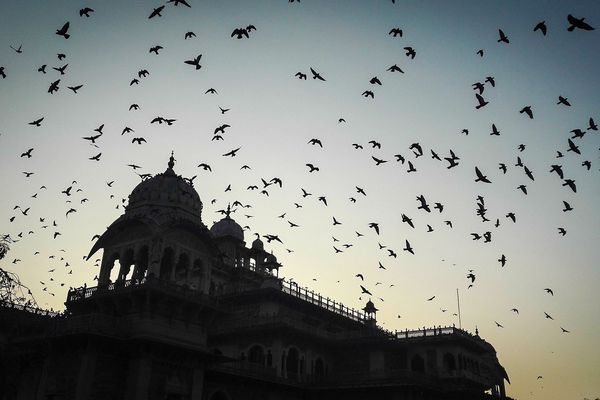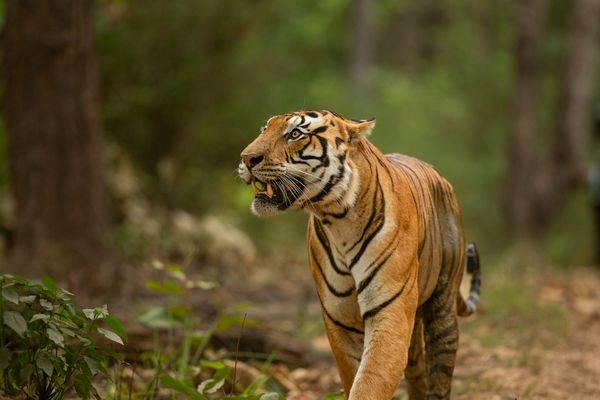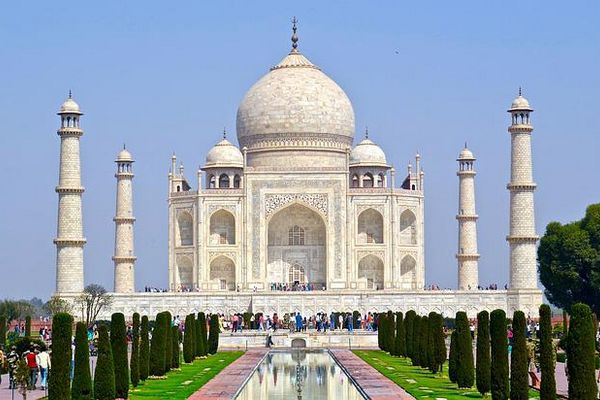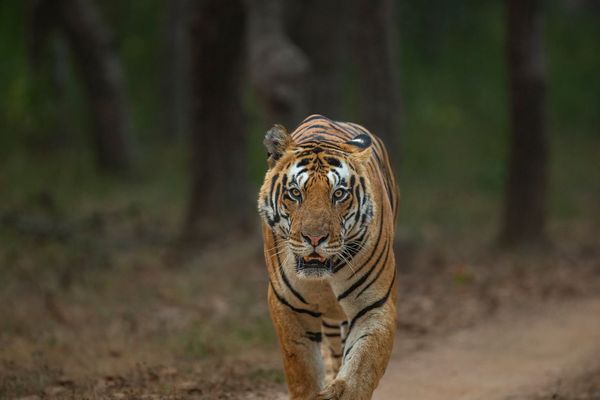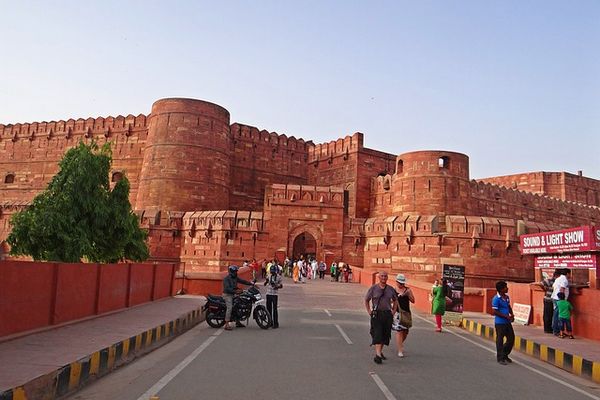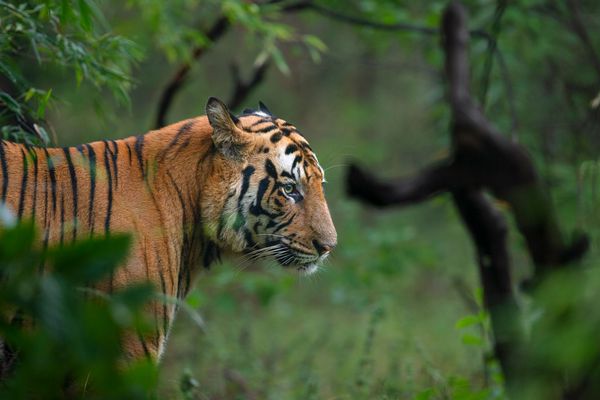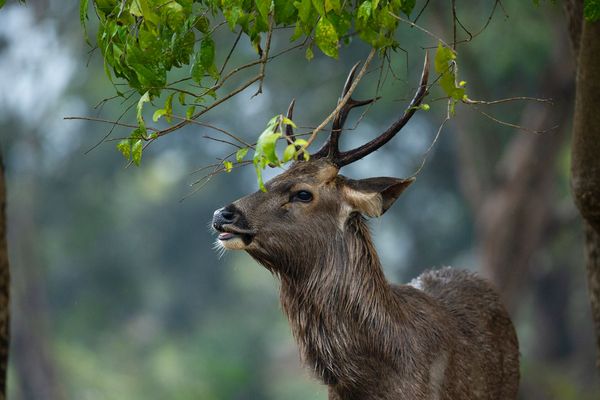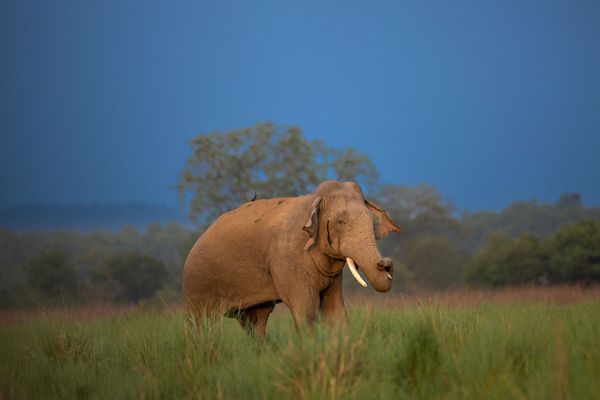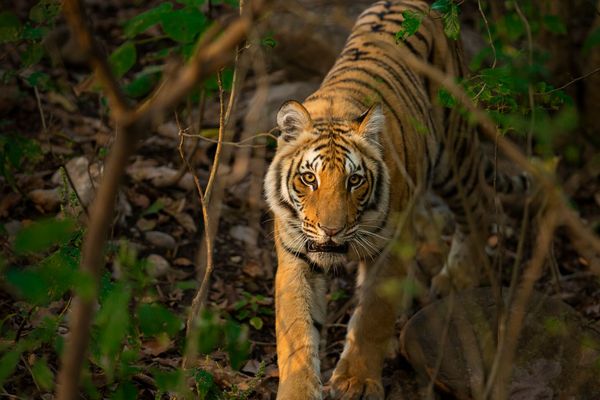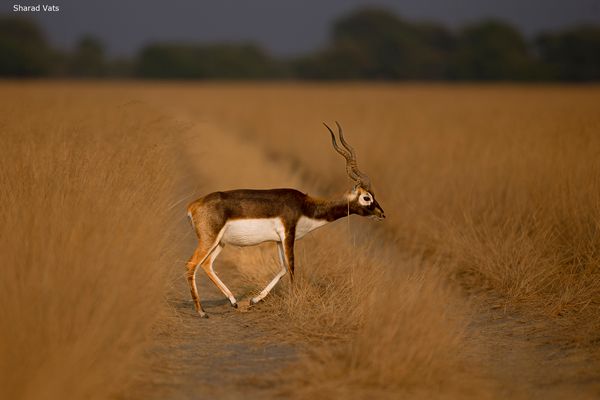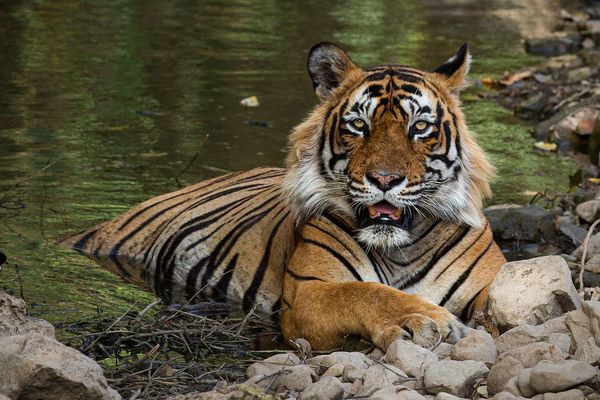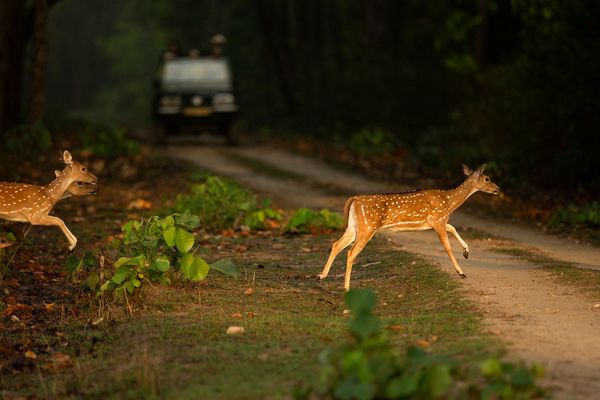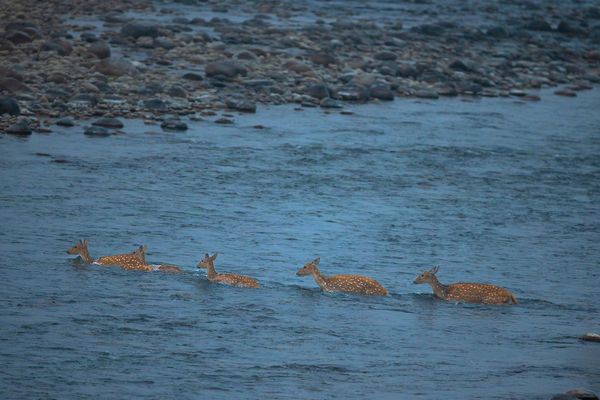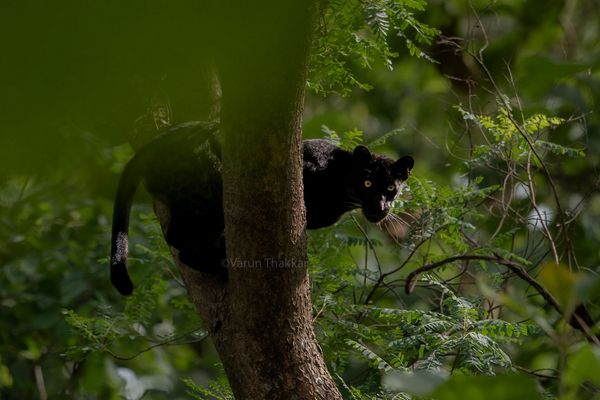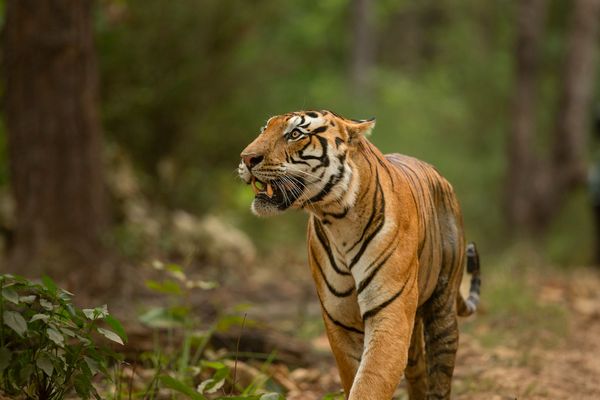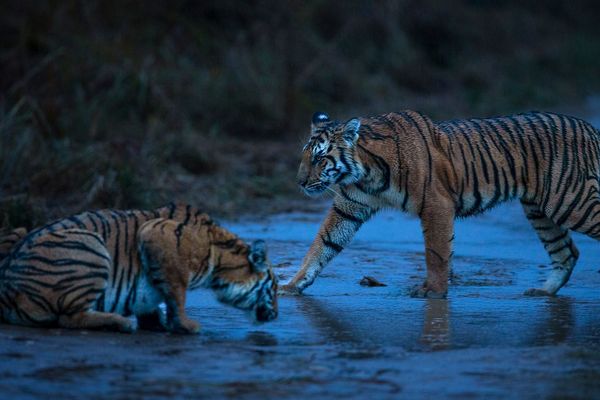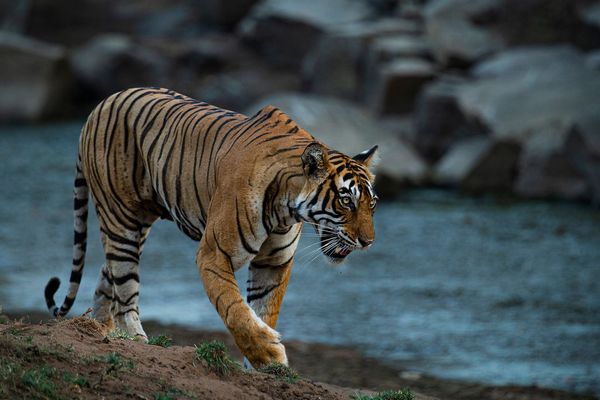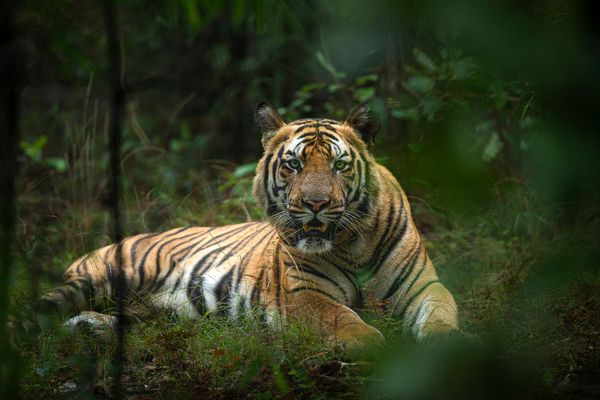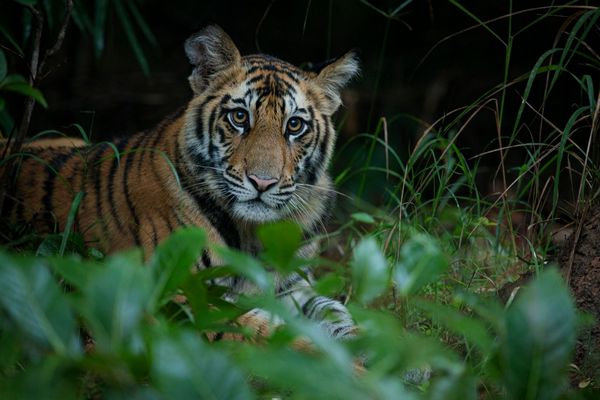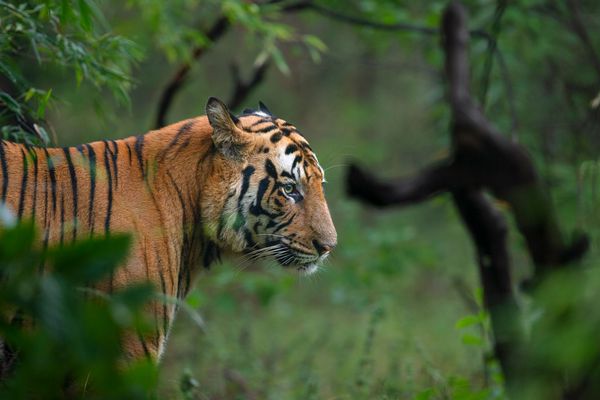Outline Tour Itinerary
- Day 01 : Arrival in New Delhi
- Day 02 : Drive To Corbett National Park (170 Miles)
- Day 03 - 04 : In Corbett National Park
- Day 05 : Corbett National Park – Agra (192 miles/6 hour drive)
- Day 06 : Agra
- Day 07 - 08 : Ranthambore National Park
- Day 09 : Ranthambore National Park – Jaipur (111 miles/3 hour drive)
- Day 10 : Jaipur – New Delhi (170 miles/6 hour drive)
- Day 11 : New Delhi – Nagpur – Pench (Flight + 62 miles drive/2 hours)
- Day 12 - 13 : Pench National Park
- Day 14 : Pench – Kanha National Park (130 miles/4 hours)
- Day 15 - 16 : In Kanha National Park
- Day 17 : Kanha – Bandhavgarh National Park (6-hour drive)
- Day 18 - 19 : In Bandhavgarh National Park
- Day 20 : Bandhavgarh – Jabalpur – New Delhi (136 miles drive + flight)
- Day 21 : Fly Back To New Delhi
Guest Testimonials
TIGER SAFARI TOUR IN GOLDEN TRIANGLE AND INDIAN WILDLIFE TOUR OVERVIEW
The “Golden Triangle” of India is without a doubt the most popular and sought-after tourist attraction in all of India. It receives more than 20 million visitors annually. This is so for the straightforward reason that India’s three most important cities—Delhi, Agra, and Jaipur—possess a great deal of natural splendour.
If you combine the urban splendour with the biodiversity hubs and national reserves that are located just a stone’s throw away from these cities, the tour becomes even more exciting. On their own, each of these three cities offers an old-world charm with their one-of-a-kind constructed architecture and breathtaking vistas, but when you combine the two, the tour becomes even more exciting.
You will travel across the triangle, stopping at five of India’s most well-known and admired national parks along the way: Corbett, Bandhavgarh, Pench, Kanha, and Ranthambore. Each of these parks is unique in its own way. Each park has something that sets it apart from the others, whether it be the flora and wildlife that can be found there or the variety of outdoor activities that can be enjoyed there. The tiger safari is, of course, an experience that cannot be skipped under any circumstances. Take a ride in a jeep to get a better look at the natural treasures that surround you.
Get a Quote
Let’s plan a perfect tiger safari tour for you. Please fill in the details and our representative will get in touch with you within 12 hours with a custom-made tiger safari tour package. You can also reach us directly on +91-9811200094 or email us at [email protected].
GOLDEN TRIANGLE AND INDIAN WILDLIFE TOUR DETAILED ITINERARY
- Day 1: Arrival in New Delhi
You will be greeted by a representative of our company when you arrive at the New Delhi Airport. This person will make sure that your transfer to the hotel goes without a hitch and will also assist you in checking in at the hotel. You will be provided with all of the travel paperwork and given an explanation of their purpose.
You will be taken on a tour of New Delhi for around half a day later in the day. Taking in the stunning panorama of the Qutub Minar is a must. In India, the title of “tallest stone tower in the world” currently belongs to an ancient stone minaret that dates back several centuries. After that, go on to India Gate, which is a war memorial arch. After that, you can walk by the magnificent President’s House, Parliament House, and Government Secretarial buildings on your way to Connaught Place, which is the hub of New Delhi and a lively commercial district.
- Day 2: Drive To Corbett National Park (170 Miles)
After a fulfilling breakfast, it is time to check out. Take the car and head to Corbett National Park. Traveling this distance by car will take you anywhere between 05 and 06 hours. The distance is 275 kilometres. When you arrive in Corbett, our officials along with the guide and the driver will be waiting for you. They will assist you in moving your bags onto a safari jeep when you arrive. You will be transported to the Dhikala Forest Lodge in this jeep (approximately 32 km from the gate).
After completing the check-in process and lunch, you will then head out on a safari in the Dhikala Zone.
Return at sunset. The Forest Rest House provided both dinner and lodging for the night.
- Day 3 & 4: Corbett National Park
Jim Corbett was a British hunter, tracker, naturalist, novelist, and conservationist. He was also a writer. The government frequently requested his assistance in eliminating the man-eating Tigers that roamed the United Provinces. It was during these travels that he underwent a metamorphosis. His writings are required reading for anybody who has an interest in the natural world. The seemingly straightforward transition from “shooting a Tiger with the rifle” to “shooting a Tiger with a camera” has been exquisitely broken down and clarified. It is quite encouraging to learn about his path as a conservationist as well as the reasons why he chose wildlife conservation over hunting wildlife. The government of India decided to rename the Ramganga National Park to the Jim Corbett National Park in recognition of his exemplary service.
There are several distinct zones and gates within Corbett National Park, just like there are at every other national park in the country. Every single one of them is stunning in its own right. Nevertheless, the Dhikala zone is where you’ll find the most film-worthy scenery (and you may call us biassed if you like). In this area, there are a few forest rest huts that are very simply furnished with the most fundamental conveniences. We are not exaggerating when we say that the site is just gorgeous beyond our imagination. Imagine you spent the night in the middle of the dense forest, and when you woke up, there were fresh Tiger pug markings outside your cottage. The excitement is unmatched by anything else. Nevertheless, the regions of Gairal, Malani, Sultan, Khinanauli, and Sarpaduli are just as gorgeous and charming as Dhikala. Each and every one of them have a certain allure and awe-inspiring qualities. In the same way as the Ramganga River makes the scenery more beautiful, the Shivalik Mountains make the zones more majestic.
The Terai Arc Landscape includes Jim Corbett National Park as one of its components. It is common knowledge that the Tigers that live in the Terai region are timid, and when they are spotted, they tend to flee the area quickly. However, in the most recent few years, it appears that the tendency is shifting. The tigers are becoming used to their surroundings and have begun to make more frequent appearances. Every location in Corbett, as well as every trail and backdrop, offers excellent photographic opportunities. The level of happiness that you will experience will skyrocket if you are able to get your chosen creature on the track, whether it be the tiger or the elephant.
Not only are the mammalian species what make this park so popular, but there are also close to 535 different kinds of birds that call Corbett National Park home.
On both days, you should go on the safaris in the early morning and in the evening. The Lodge will provide lodging, as well as meals.
- Day 5: Corbett National Park – Agra (192 miles/6 hour drive)
After breakfast in the early morning, you will need to check out. Drive to Agra, which is a distance of 310 kilometres. This should take you approximately six hours to complete. Get to Agra by the late afternoon at the latest. Enjoy the day at your own leisure. A hotel in Agra for dinner and the night’s accommodations.
- Day 6 : Agra
Visit the Taj Mahal the following morning, which is widely regarded as one of the seven wonders of the world due to its stunning architecture and design. It was designed by the Mughal emperor Shah Jehan to be a monument of love for his wife Mumtaz, and it was constructed in the middle of the 1700s. Over 20,000 people from different parts of the world contributed their time and effort to the construction of this magnificent mausoleum. It was immortalised in white Makrana marble and embellished with onyx, amethyst, lapis lazuli, turquoise, jade, crystal, and several other semi-precious stones that were brought from as far away as Tibet, China, and the Indian Ocean. Following lunch, make your way to Ranthambore. Arrive at your safari lodge and check in. After lunch, you should get ready for the afternoon safari. (It is important to note that visitors will not be able to access the Taj Mahal on Fridays.)
- Day 7 & 8: Ranthambore National Park
On both days, you should go on the tiger safaris in the morning and the evening at the Ranthambore national park.
The entirety of the park is separated into ten distinct zones, and the majority of these zones support healthy populations of tigers and other animals. Project Tiger was initiated in Ranthambore National Park, which was one of the very first national parks to host the programme. It has had a fluctuating Tiger population over the course of the past century, but Ranthambore has been on a rather even keel over the course of the past decade. To such an extent that it was able to donate a few tigers to Sariska National Park, which was devoid of tigers as a result of activities known as poaching.
Both the hardworking Forest Department and the tourism industry deserve all of the credit for Ranthambore’s success, which includes a robust tiger population. The Ranthambore Tiger Reserve is located in the state of Rajasthan in India. It is made up of several distinct areas, each of which has its own unique conservation history. These areas are also geographically distinct from one another, with only a few narrow corridors connecting them to Ranthambore National Park, the reserve’s central location. The majority of these are located in Ranthambore National Park, Sawai Mansingh Sanctuary, and Keladevi Sanctuary.
The Indian golden triangle trip and tiger safari both include a stop to the spectacular Ranthambore National Park, which is a photographer’s dream location. Ranthambore is attractive in its own unique manner since there are so many different types of lighting, perspectives, and backdrops, and you can take pictures there using any frame you like. In addition, there are over 300 different species of birds that may be found inside the park’s boundaries. Ranthambore National Park and the areas surrounding it are, in point of fact, a bird watcher’s dream come true. The large cormorant, the painted spurfowl, the sarus crane, the bronzed winged jacana, the sandpiper, the kingfisher, the nightjar, the painted sandgrouse, and the great horned owl are just some of the key species that make their annual migration from their breeding grounds to the north of the Himalayas to Ranthambore and the areas surrounding it for the winter.
The name of this park, which spans an area of 400 square kilometres and is home to rocky hill crests that descend to open valleys between the Aravali and Vindhya ranges, is derived from the thousand-year-old fortress that looms above the forest. Ranthambore is home to a wide variety of flora and fauna, including tigers, leopards, and sloth bears. Ranthambore is a very rare and unusual region where a natural present meets a historical past. It is most well-known for the diurnal activity of tigers, which may be seen there. Sambar, Cheetal, Chinkara, Nilgai and Languor. This reserve is home to the elusive leopard as well as tigers, and visitors who go on safari have a very strong chance of spotting tigers during their excursions. The crumbling remnants of its former greatness may be found strewn across the terrain. These ruins can take the form of chatris or cupolas, and they resemble palaces or old guard stations. These ruins all contribute to the mystical and ethereal atmosphere of this vast wilderness.
- Day 9: Ranthambore National Park – Jaipur (111 miles/3 hour drive)
You will have breakfast first thing in the morning, then check out and drive to Jaipur. In approximately three hours, the distance of 180 kilometres will be reached. Check into your hotel as soon as you get there. After a filling lunch, you will next go sightseeing in Jaipur’s most famous attractions (Jantar Mantar, Hawa Mahal, City Palace and the Museum). Another thing that makes this city famous is its shopping. When you visit the ‘Jaipuri Bazaar,’ you will notice that the culture is much more vibrant than usual due to the abundance of rare stones and handicrafts.
Come back to the hotel, where you can relax for the rest of the evening.
- Day 10: Jaipur – New Delhi (170 miles/6 hour drive)
It is time to check out of the hotel after breakfast. Pay a visit to the Amer Fort, which served as the home of the Rajput Maharajas and their families in the past. It is a luxurious palace that has been built on a total of four storeys. In addition to being a hill fort, this location is also a World Heritage site. After that, continue driving for around five to six hours over 275 kilometres to reach New Delhi, which is the capital of India.
- Day 11: New Delhi – Nagpur – Pench (Flight + 62 miles drive/2 hours)
The hotel in Delhi requires guests to check out. In order to board an internal flight from New Delhi to Nagpur, you will need to make your way to the Domestic Terminal at the New Delhi Airport. When you arrive in Nagpur, our agent will be there to greet you, and they will also provide transportation to and from the airport to Pench National Park. Traveling this distance by car should take about two hours as it is 62 miles or 100 kilometres. Check in with your Lodge as soon as you get there.
After lunch, we will get started on our afternoon safari. Come back to the Lodge when the sun has set. Dinner and lodging for the night were provided by the Lodge.
- Day 12 & 13: Pench National Park
On both days, you should go on the park safari in both the morning and the afternoon. On two days, lodging at the Lodge, including breakfast and dinner.
The word “Pench” is synonymous with serenity and beauty because it is one of the most stunning parks in the central region of India. Along with Kanha, it creates a passageway for tigers and supports a thriving population of felines. In addition, there are quite a few leopards and an incredible variety of avian species to be found there. The River Pench separates the park into two distinct zones: the eastern half and the western half. As the sun begins to set, it is a great opportunity to observe the transformation of the forest into its nocturnal state. The Pench forest is home to a number of nocturnal birds and animals that are active after dark.
- Day 14: Pench – Kanha National Park (130 miles/4 hours)
Have a guided tour through the park first thing in the morning. Come back to the lodge for breakfast, then take some time to recover. After lunch, we will head in the direction of Kanha National Park. It will take you approximately four to five hours to get to this location, which is situated 210 kilometres away from Pench. Upon arrival, guests will be transferred straight to the safari lodge located in Kanha. You are free to spend the rest of the day at your leisure, or you could even visit the village of the indigenous people nearby and engage in conversation with them.
- Day 15 & 16: Kanha National Park
On both days, you should go on tiger safari in Kanha National Park in the early morning and in the evening.
It is one of the most well-known stops on the golden triangle trip that includes a tiger safari because it was the inspiration for Rudyard Kipling’s classic novel The Jungle Book. Kanha is both one of the largest and most beautiful parks in India. It is also home to a diverse collection of animals. It is one of the best sites to watch the Tiger in addition to various other species of flora and fauna that can be found there. There are several bodies of water to be found in Kanha, which attracts a sizable bird population, both permanent and temporary. It is a breathtaking scene with thick vegetation that gradually gives way to meadows covered in grass. The park staff will bring your breakfast to you and serve it to you on the hood of your jeep.
After the morning’s safari, come back to the lodge and refresh yourself. After a laid-back lunch, it’s time to start your afternoon safari in the unspoiled nature of Kanha National Park.
- Day 17: Kanha – Bandhavgarh National Park (6-hour drive)
Following your early morning safari, make your way back to the resort. You should get an early lunch and then check out of the hotel; after that, you will start the six-hour drive to Bandhavgarh National Park. Bandhavgarh should be reached somewhere in the early evening. After you’ve checked into your Safari Lodge, the remainder of the day is yours to spend as you like.
- Day 18 & 19: Bandhavgarh National Park
You will get to go on tiger safari in Bandhavgarh both in the early morning and in the afternoon on both days.
Bandhavgarh is both one of the most gorgeous parks in Central India and a place with a long and illustrious history. The park was given its name after the fort that can be seen rising over the surrounding vegetation. Spend the morning on an exciting ride through the park, and then make your way back to the lodge in the late afternoon.
It is rather odd to go to this park and not see any tigers, given that it is so well-known for the enormous tiger density that exists within its dense Sal and Bamboo trees. In addition to being excellent territory for tigers, Bandhavgarh is also the native habitat of another large cat species known as the leopard. These secretive critters are seen among the thick foliage in the treetops, along with a variety of bird species, both migratory and resident. The park is home to a robust population of free-ranging animals, including wild boars, sloth bears, porcupines, foxes, monkeys, and a variety of other species.
- Day 20: Bandhavgarh – Jabalpur – New Delhi (136 miles drive + flight)
Bandhavgarh has a morning tiger safari that you don’t want to miss, so make sure you get up early. Bring yourself back to the lodge in time for breakfast before you have to check out. You will be given with a car that is driven by a chauffeur so that you can go from Bandhavgarh National Park to Jabalpur Airport. Traveling this distance will take around four hours and cover a total of 220 kilometres.
Proceed to the airport in Jabalpur to board your aircraft to New Delhi. You will be greeted by one of our representatives at the airport as soon as you arrive at the Domestic Terminal in New Delhi. At the hotel in Delhi, he will assist you with checking in to your room.
- Day 21: Fly Back To New Delhi
Post an early breakfast, transfer to the International Terminal of the New Delhi Airport to board your onward flight home.
Enquire This Tour
Let’s plan your tiger safari tour. Please fill in the requirements below and our representative will get back to you with a custom safari package.
Guest Testimonials
What our guests are saying about us?

My husband and I did a 10 day "Just Tigers" safari. We visited Pench, Kanha and Bandhavgarh reserves. It was not high season but yes we had wonderful tiger sightings. The level of profession of these lovely people was so refreshing. For this type of trip you do want people who know what they are doing and a comfortable place to return to after long safari drives.

India. A country that has fascinated me for years. I finally decided it was time to visit and see it for myself. My husband and I both love nature, wildlife and birds so when I came across Nature Safari India I decided to make enquires.
We wanted to do the golden triangle tour as well as visiting national parks and seeing some of the ‘real’ India.

This is the 2nd time we have travelled with Nature Safari India. We had a 17 night holiday, visiting the nature of Sasan Gir National Park, Little Rann of Kutch, Velavadar Black Buck National Park and Leopard Hills at Bera. The nature was interspersed with various amounts of culture along the way. We had another amazing tour, with some stunning accommodation selected by the company

This was our second tiger safari at Corbett with Nature Safari and turned out to be worth every penny. We saw 7 tigers in 3 days and from quite close distance too. The best part was seeing a tigress wit her 2 grown cubs who crossed our path and walked in front of us for several minutes before crossing over and heading to a water hole where we saw them for hours drinking


